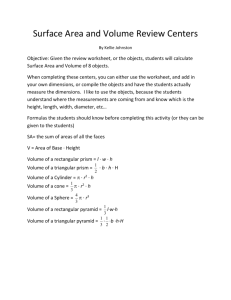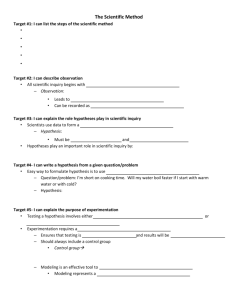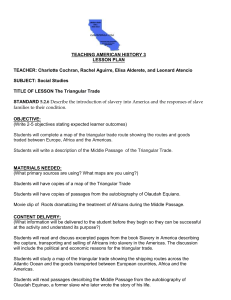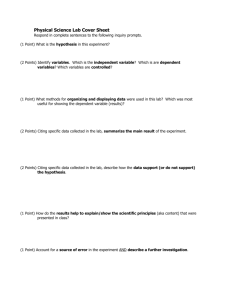Inquiry Lesson
advertisement
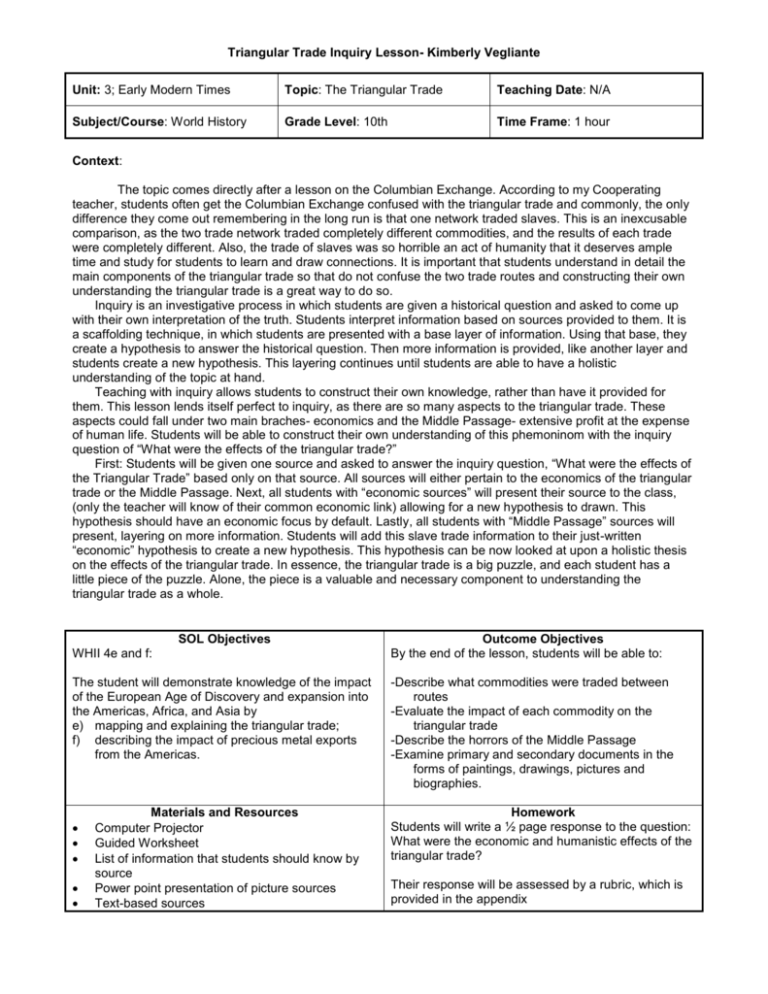
Triangular Trade Inquiry Lesson- Kimberly Vegliante Unit: 3; Early Modern Times Topic: The Triangular Trade Teaching Date: N/A Subject/Course: World History Grade Level: 10th Time Frame: 1 hour Context: The topic comes directly after a lesson on the Columbian Exchange. According to my Cooperating teacher, students often get the Columbian Exchange confused with the triangular trade and commonly, the only difference they come out remembering in the long run is that one network traded slaves. This is an inexcusable comparison, as the two trade network traded completely different commodities, and the results of each trade were completely different. Also, the trade of slaves was so horrible an act of humanity that it deserves ample time and study for students to learn and draw connections. It is important that students understand in detail the main components of the triangular trade so that do not confuse the two trade routes and constructing their own understanding the triangular trade is a great way to do so. Inquiry is an investigative process in which students are given a historical question and asked to come up with their own interpretation of the truth. Students interpret information based on sources provided to them. It is a scaffolding technique, in which students are presented with a base layer of information. Using that base, they create a hypothesis to answer the historical question. Then more information is provided, like another layer and students create a new hypothesis. This layering continues until students are able to have a holistic understanding of the topic at hand. Teaching with inquiry allows students to construct their own knowledge, rather than have it provided for them. This lesson lends itself perfect to inquiry, as there are so many aspects to the triangular trade. These aspects could fall under two main braches- economics and the Middle Passage- extensive profit at the expense of human life. Students will be able to construct their own understanding of this phemoninom with the inquiry question of “What were the effects of the triangular trade?” First: Students will be given one source and asked to answer the inquiry question, “What were the effects of the Triangular Trade” based only on that source. All sources will either pertain to the economics of the triangular trade or the Middle Passage. Next, all students with “economic sources” will present their source to the class, (only the teacher will know of their common economic link) allowing for a new hypothesis to drawn. This hypothesis should have an economic focus by default. Lastly, all students with “Middle Passage” sources will present, layering on more information. Students will add this slave trade information to their just-written “economic” hypothesis to create a new hypothesis. This hypothesis can be now looked at upon a holistic thesis on the effects of the triangular trade. In essence, the triangular trade is a big puzzle, and each student has a little piece of the puzzle. Alone, the piece is a valuable and necessary component to understanding the triangular trade as a whole. SOL Objectives WHII 4e and f: The student will demonstrate knowledge of the impact of the European Age of Discovery and expansion into the Americas, Africa, and Asia by e) mapping and explaining the triangular trade; f) describing the impact of precious metal exports from the Americas. Materials and Resources Computer Projector Guided Worksheet List of information that students should know by source Power point presentation of picture sources Text-based sources Outcome Objectives By the end of the lesson, students will be able to: -Describe what commodities were traded between routes -Evaluate the impact of each commodity on the triangular trade -Describe the horrors of the Middle Passage -Examine primary and secondary documents in the forms of paintings, drawings, pictures and biographies. Homework Students will write a ½ page response to the question: What were the economic and humanistic effects of the triangular trade? Their response will be assessed by a rubric, which is provided in the appendix Triangular Trade Inquiry Lesson- Kimberly Vegliante Rubric for homework assessment Instructional Procedures: Before the lesson Group students into pairs based on their ability (see “differentiation” section below) Predetermine which “source” each pair will receive based on their ability. In total, there are 10 data sets: -1 Triangular trade source (do not give to students, used for teacher to model) -5“economic” sources -4 “Middle Passage” sources All sources that are in picture form are also on a power point presentation in order of how they will be presented. When students are presenting their sources with pictures, the pictures will be projected on the board, so that the rest of the class has a clear visual to investigate. Ensure that the picture sources all have a written description on the back (the descriptions can be found in the “notes” section of the power point) Step by Step Implementation: Hand out guiding inquiry worksheet Hand each “predetermined pair” their source Ask students to study their source and describe it. This is #1 on their guided worksheet. ____________ In order to model how the hypothesis writing and presentations should go, the teacher will describe his/her source to the class, write a hypothesis for it, then present it to the students. This source is the Triangular Trade Introduction, which includes: -Triangular Trade map source -Triangular Trade Text Excerpt The teacher should clarify any confusion before moving on ____________ Solely based on their source and nothing else, each pair will come up with their initial hypothesis for the inquiry question, “What were the effects of the triangular trade?” This is #2 on their guided worksheet. ____________ Next, I will have each pair with “economic sources” present to the class. The students will not know that they have an “economic source.” They will think I am just calling them up randomly. The order in which the “economic sources” should present by group is: 1. The profitability of the triangular trade, which includes: - Profitability excerpt 2. Rum and the triangular trade packet, which includes: - Rum excerpt - Picture of Rum Bottle - Picture of Sugar Came 3. “Slaves as commodities” photograph packet, which includes -slave auction advertisement -slave receipt -slave record book 4. Economics overview, which includes: -textbook excerpt After each group has presented, they should not be dismissed from presenting until the teacher has ensured they have hit every important piece of information. If students have no touched upon a topic, the teacher will ask probing questions until they do. Each student will take notes about each other’s sources. There is space on their guided worksheet to bullet point about the new information they are receiving. This is #3 on their guided worksheet. Triangular Trade Inquiry Lesson- Kimberly Vegliante After all the “economic” sources have gone, I will ask students to create a new hypothesis over the question, “What were the effects of the triangular trade?” Their answer should be shaped by economics. This is #4 on their guided worksheet. ____________ Now, the “Middle Passage” pairs will present The order that the “Middle Passage sources should be presented is: 1. “Slave Ship Life” picture packet, which includes: - Crammed slaves on the decks of the slave ship Brookes -“spoon” position -“Scene in the Hold of the Blood Stained Gloria: art depiction -Slave ship throwing slaves overboard, “Negrier Poursuivi” art depiction 2. “Restraints” photo packet, which includes: - collogue of 4 different restraints (leg irons, iron collar, yokes, and neck ring) -representation image of yokes being used -“nine cords” whip 3. Mutiny, which includes: -Cinque biography 4. Slave perspective, which includes: - Olaudah Equiano book excerpt 5. Middle Passage overview, which includes: -Middle Passage excerpt After each group has presented, they should not be dismissed from presenting until the teacher has ensured that have hit every important piece of information. If students have no touched upon a topic, the teacher will ask probing questions until they do. Each student will take notes about each other’s sources. There is space on their guided worksheet to bullet point about the new information they are receiving. This is #5 on their guided worksheet. ____________ After students are done presenting, the class will have all the information needed to create a final thesis on, “What is the effect of the triangular trade?” This is #6 on their guided worksheet. It is imperative that the teacher explain the differences between a thesis and hypothesis in this step. A hypothesis is a tentative explanation, whereas a thesis is a statement that can be supported by information. By having student write a thesis, it will show them they have understood all aspects of the Triangular Trade. Differentiation: Before the lesson, students will be grouped according to ability and interests. The sources were especially chosen in mind to complement low to high level readers. Students who struggle with reading the most will receive a picture source. Students who need a challenge will receive text sources. Interest will also be taken into account. For example, if I know a student likes math and is a good reader, I will give him/her an economic text source. If I know a student is a visual learner and likes art, I will give him/her one of the slave ship visual sources. The differentiation of this lesson therefore concerns content and process. Accommodations / Modifications: This lesson lends itself well to students that might need modifications or adaptions. I can match a student to a source if their IEP or 504 plan calls for a certain type of learning. Assessment (Formative) (Summative) This lesson has a lot of checkpoints to assess Students will hand in their guided inquiry student understanding. First there are two worksheet, as well as their homework assignment hypothesis writings, and one thesis writing that the the next day in class. Their learning will also be teacher can read and make sure students are on assessed in the unit test. track. Also, each pair will present their sources, so students will be able to ask questions during the presentation of each source. Triangular Trade Inquiry Lesson- Kimberly Vegliante Reflection: I have thought of issues that might arise from this lesson. Students might not understand what is going on at first, so I will be sure to give a detailed synopsis of inquiry and my objectives before the lesson starts. I do realize that student have probably never been asked to come up with a hypothesis in a social studies environment, so I will have review other ways to express a hypothesis other than the scientific “if/than” statement. I also need to be ready to consolidate or separate sources if I have class with fewer students or more. Post-teaching Reflection: I was correct in thinking that student’s would be confused with writing a hypothesis for social students. Before the lesson, I wound up having to give my students a mini lesson on how to write a hypothesis, what a thesis was, and why one builds on the other. Next time I teach inquiry, I will need to incorporate time into the lesson to go over these essential terms. It was also exciting to see actually scaffolding taking place right before my eyes. During the economics “layer,” I asked students why they gave sailors rum on the slave ships and the answer was to placate them. A girl raised her hand and said, “I don’t see why they needed to be placated, it was their job.” And I responded, “Well, if you hold on to that question, you will be able to answer it on your own in about 30 minutes, when we are done with the lesson [and get through the Middle Passage “layer.”] Triangular Trade Inquiry Lesson- Kimberly Vegliante Appendix: 1. Guided Inquiry Worksheet 2. Power Point of picture sources (with descriptions in “notes” section) 3. Text sources -Olaudah Equiano excerpt -Cinque biography -Triangular trade profitability excerpt -Triangular Trade rum excerpt -Triangular Trade textbook excerpt -Middle Passage textbook excerpt -Economics textbook excerpt 4. Information to highlight from each source 5. Homework rubric



